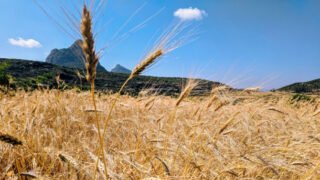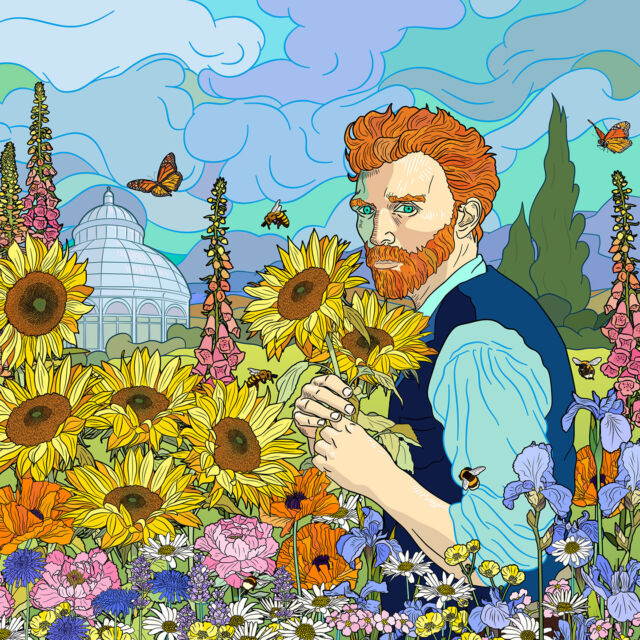Maslins vs. Monocrops: How Looking to the Past Can Change the Future

A senior pastor of a church in Dedoflis Tskaro, in eastern Republic of Georgia, stands in his field of mixed barley and wheat. Photo courtesy of Alex McAlvay.
We talk a lot about plants here at NYBG. And a big part of plant life, at least in the ways that they relate to us, is agriculture. With modern agricultural methods presenting challenges to sustainability and the environment, it’s important to think beyond our rigid structures and dive into other ways of knowing—ecological, Indigenous, traditional, and historical.
Take it from Alex McAlvay, Ph.D., an assistant curator at NYBG’s Institute of Economic Botany, where he works with various communities around the world to understand and revitalize traditions of sustainable agriculture and management of wild resources.
Studying tradition and history means Dr. McAlvay’s research takes on a broad scope. Some is geographically close to NYBG: in Long Island, he works with the Shinnecock Nation to document traditional plant knowledge and burning practices. Others are far from the Garden, like in British Columbia, where Dr. McAlvay works with First Nation communities to understand traditionally managed wild resources, including human-planted forest, saltmarsh, and prairie gardens that were abandoned due to colonialism. Even further out, like in Mexico, he is working to study how a community’s endangered language is intertwined with ecological information, which is often encoded in plant names.
For this blog post, we’ll be focusing on a project with an even larger range: studying a specific agricultural practice used historically across a large part of the globe.
Let’s talk about agriculture for a moment. When you think about modern industrial agriculture, what do you think of? Vast expanses of Iowa corn fields? Rows of wheat that stretch to the thin horizon line of North Dakota? If you think too hard about it, you’ll get vertigo: too much of the same thing, repeated over and over as far as the eye can see—and as many times as the land can take.
They may yield high volumes under the right conditions, but these monocrops are often more susceptible to disease, pests, and other natural disasters. With such little diversity, the resilience of the crop tends to be low.
There are several shortfalls of monocrops:
- Pests can easily target them—their favorite food, all in one place!
- A single disease can wipe everything out—since it’s one kind of crop, everything will have similar vulnerabilities.
- Monocrops often provide poor habitat for pollinators, as well as predators of pests.
- Too much of the same crop can quickly deplete nutrients in the soil, whereas a mixture of crops will not have the same demand on the soil, and some will even replenish the soil in various ways.
Throughout history, there are many examples of the vulnerability and fragility of monocrops. You’ve probably heard of potato famines and southern corn blight. But what about the fusarium wilt of the banana? That’s a fungal disease that would certainly take a toll on your Sunday pancakes.
And with climate change, this will only get worse.
“There’s a need to feed a growing population around the world…[but] climate change is anticipated to hit agriculture particularly hard,” said Dr. McAlvay. “It’s thought that it’s going to reduce yields of crops by up to 17% by 2050…by the same year, we’ll have to increase production by 50%.”
Speaking of climate change, agriculture in its current form is a major emitter of greenhouse gases (GHGs)—which trap heat in the atmosphere, causing the planet to warm. Carbon dioxide is just one GHG, and agriculture produces not only that, but also nitrous oxide and methane. According to the United States Environmental Protection Agency, in 2021, agriculture (including crops and livestock) produced 10% of overall GHG emissions in the U.S.
Modern agriculture also uses a lot of land. According to the Food and Agriculture Organization of the U.N., agricultural land area accounts for 38% of the global land surface (one-third of this is used as cropland, and two-thirds as pastures for livestock). The U.S. has the second greatest agricultural land coverage after China, with 400 million hectares, or around 988 million acres.
How can we change our current agricultural system to accommodate our rising population, but also cut down on emissions and remain resilient in the wake of a changing climate? Thankfully, we have models from thousands of years of traditional farming, which use the timeless benefits of biodiversity. Instead of monocrops (or monocultures), most of these farmers use, or used, a system of polycultures, so that two or more crops are planted together.

Farmers look at mixtures of wheat and barley for harvest.
A commonly known polyculture is the “Three Sisters.” Used in many Indigenous North American cultures, this traditional agricultural method consists of corn, beans, and squash all grown in the same plot of land. In Mexico, where it has been used for millennia, it’s also referred to as a milpa system.
“So, for example, this is a Mayan milpa system where you have this patchwork of old forest, young forest, newly cleared land, corn, beans, and squash,” said Dr. McAlvay. “[It’s a] contrast to this super homogenous, endless expanse which is an ideal condition for pests.”
The “sisters” namesake is clear from the plants’ growing patterns. The corn grows tall and sturdy and provides a support for the beans; the beans contribute essential nitrogen to the soil; and the squash serves as protection, with bristly leaves and vines that ward off pests and cover the soil to keep moisture in. These plants not only help each other, but also benefit the communities that grow them, providing a balanced diet and important nutrients all within a single planting and harvest.
Diversity also provides a buffer—the more crops you plant, the more likely something will work out. As Dr. McAlvay says, it’s a sort of insurance policy.
“In this system, you might have five different varieties of corn—so you might lose your yellow corn, but you still have your blue and red corn, your squash and your peppers and beans,” said Dr. McAlvay. “It’s a strategy that farmers have used forever to basically manage risk, and also diversify nutrition.”
Dr. McAlvay isn’t studying the Three Sisters exactly, but he is researching something similar: maslins.

A farmer in Ambasel District, Amhara, Ethiopia holds a mixture of wheat and barley varieties.
Maslins are mixtures—multiple varieties of grains grown in the same field, such as wheat and barley. In their native habitat in the Fertile Crescent, these two grains are often found together in the wild, growing side-by-side for tens or hundreds of thousands of years.
“In the wild ecosystems where they grow, these plants happen to have evolved there,” said Dr. McAlvay. “It’s the same reason we might find oak trees and maple trees in our forests.”
Farmers took the hint and started growing them in unison, in areas including Spain, China, Ethiopia, and Scotland. But in the 20th century—specifically the Green Revolution of the ’60s—the push to grow uniform crops won out, and maslins disappeared in most areas.
Dr. McAlvay set out to learn about this polyculture method throughout history: which communities have used it in the past, and how it’s still being used today, particularly in Ethopia and the Republic of Georgia, Lebanon, Morocco, and the UK. Understanding these grain mixtures called for yet another mixture—that of research materials: ethnographic and ethnobotanical literature, agricultural trials, agronomic evidence, and interviews. Through these, Dr. McAlvay slowly pieced together how maslins have been used across history.
Some of the research was hidden away in old records.
“The only way we figured out that these crops were grown in mixtures in Bosnia or Serbia or Albania was from old Ottoman Empire Records that showed that this much tax was extracted from these countries as mahlut, which means maslin in Turkish.”

Map of historical and present grain mixtures, courtesy of Alex McAlvay.
Some of it was more easily documented, by farmers who proved the currency of this method.
“In Georgia, we interviewed farmers. They have eight different mixtures that they remembered planting,” Dr. McAlvay said. “And they said this produces more because the sturdy stems of the wheat hold up the barley and keep it from flopping into the mud.”
Planting both grains at the same time and in the same location provides a built-in back-up plan: maybe there’s a drought and the barley does better than the wheat. Or maybe there are heavy rains and the wheat does better. With climate change leading to intensified natural disasters and shifts in precipitation and temperature, this is important. Growing multiple crops builds resilience.
Another plus: maslins are easily harvestable. You can drive a tractor through the fields and get all the grain at once. Good thing we’ve had the technology to separate wheat and barley for over 100 years!
“Farmers have been doing this forever, but we suddenly stopped in many places,” said Dr. McAlvay. “And so, I think we’re doing this radical experiment now of widespread monoculture.”
So, why are we hesitating to reimplement maslins?
“There isn’t really a big barrier to scaling this up in our farms. The only barrier is the resistance to the idea of it,” said Dr. McAlvay. “I think there’s a strong idea in the public consciousness about uniformity and purity…anything that’s a mixture is impure or backwards.”

Wheat and barley grown together in a field in Adwa District, Tigray, Ethiopia. Photo Courtesy of Alex McAlvay.
However, it’s not that far off from something we’ve already been doing. Dr. McAlvay said that crop rotation—which is a traditional practice—has been in the public consciousness for a long time, and has even been used commercially due to its soil benefits. For example, if you plant a field of corn, then harvest, then plant soybeans, and alternate from year to year, you can save on fertilizer. The soybeans fix some nitrogen in the soil, and the soil isn’t as depleted of nutrients.
“[Using maslins] isn’t such a big leap from that,” said Dr. McAlvay. “It’s just growing them at the same time in the same field. That seems to have a little bit of resistance for some reason.”
As his research continues, Dr. McAlvay’s goal is to combine his study of the maslins’ attributes of climate resiliency along with nutritional analyses to understand if the two are complementary. With these mechanisms, he hopes it’ll change the way we think about crops—especially in the wake of a changing climate.
“With climate change, it really reinforces the need for these strategies that are basically geared toward dealing with uncertainty,” said Dr. McAlvay.
SUBSCRIBE
Enter your email address to subscribe to this blog and receive updates on new posts.











